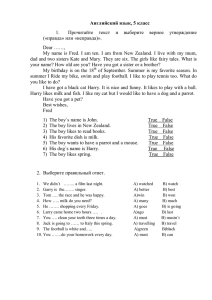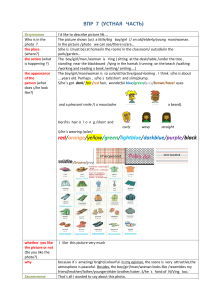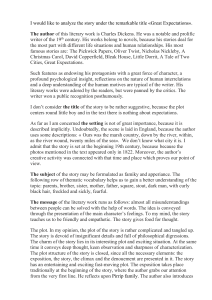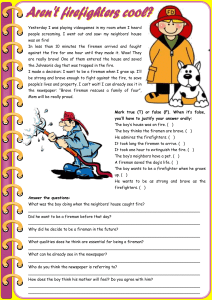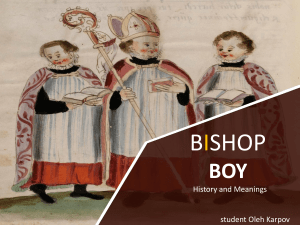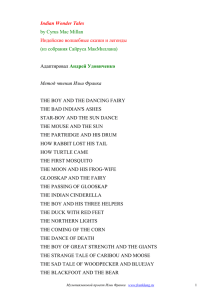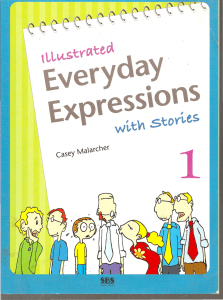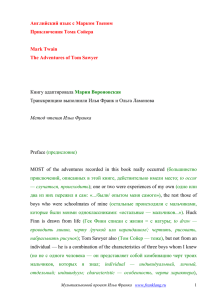Exercise 1. Practice reading the names of some world
реклама
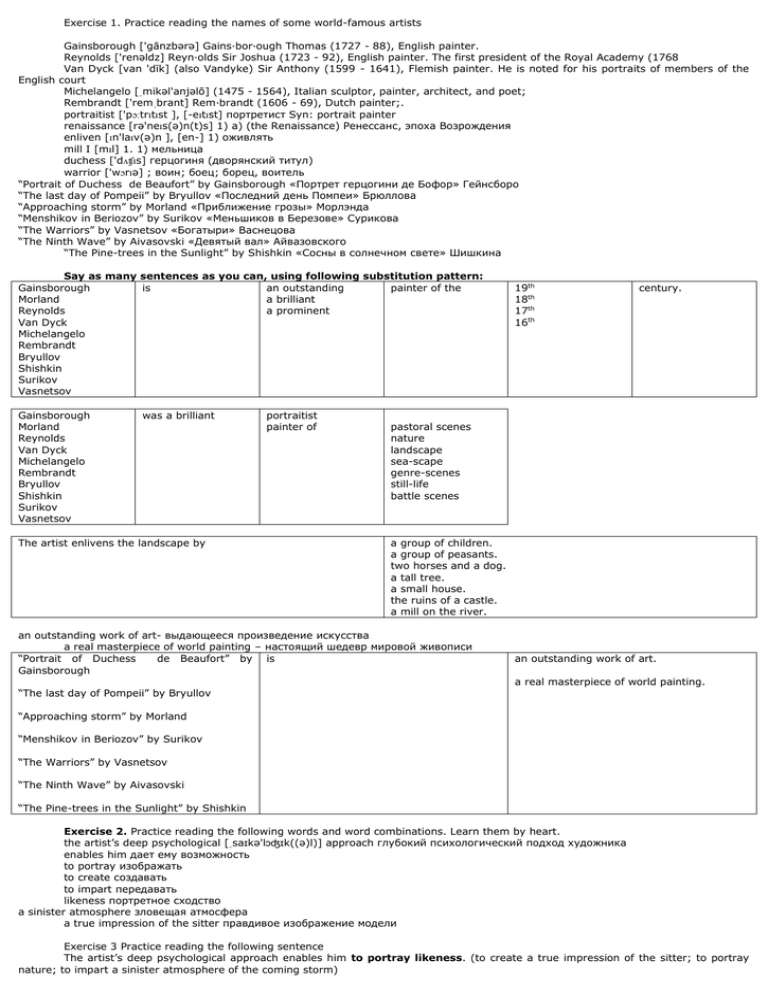
Exercise 1. Practice reading the names of some world-famous artists Gainsborough ['gānzbərə] Gains·bor·ough Thomas (1727 - 88), English painter. Reynolds ['renəldz] Reyn·olds Sir Joshua (1723 - 92), English painter. The first president of the Royal Academy (1768 Van Dyck [van 'dīk] (also Vandyke) Sir Anthony (1599 - 1641), Flemish painter. He is noted for his portraits of members of the English court Michelangelo [ˌmikəl'anjəlō] (1475 - 1564), Italian sculptor, painter, architect, and poet; Rembrandt ['remˌbrant] Rem·brandt (1606 - 69), Dutch painter;. portraitist ['pɔːtrɪtɪst ], [-eɪtɪst] портретист Syn: portrait painter renaissance [rə'neɪs(ə)n(t)s] 1) а) (the Renaissance) Ренессанс, эпоха Возрождения enliven [ɪn'laɪv(ə)n ], [en-] 1) оживлять mill I [mɪl] 1. 1) мельница duchess ['dʌʧɪs] герцогиня (дворянский титул) warrior ['wɔrɪə] ; воин; боец; борец, воитель “Portrait of Duchess de Beaufort” by Gainsborough «Портрет герцогини де Бофор» Гейнсборо “The last day of Pompeii” by Bryullov «Последний день Помпеи» Брюллова “Approaching storm” by Morland «Приближение грозы» Морлэнда “Menshikov in Beriozov” by Surikov «Меньшиков в Березове» Сурикова “The Warriors” by Vasnetsov «Богатыри» Васнецова “The Ninth Wave” by Aivasovski «Девятый вал» Айвазовского “The Pine-trees in the Sunlight” by Shishkin «Сосны в солнечном свете» Шишкина Say as many sentences as you can, using following substitution pattern: Gainsborough is an outstanding painter of the Morland a brilliant Reynolds a prominent Van Dyck Michelangelo Rembrandt Bryullov Shishkin Surikov Vasnetsov Gainsborough Morland Reynolds Van Dyck Michelangelo Rembrandt Bryullov Shishkin Surikov Vasnetsov was a brilliant The artist enlivens the landscape by portraitist painter of century. pastoral scenes nature landscape sea-scape genre-scenes still-life battle scenes a group of children. a group of peasants. two horses and a dog. a tall tree. a small house. the ruins of a castle. a mill on the river. an outstanding work of art- выдающееся произведение искусства a real masterpiece of world painting – настоящий шедевр мировой живописи “Portrait of Duchess de Beaufort” by is Gainsborough “The last day of Pompeii” by Bryullov 19th 18th 17th 16th an outstanding work of art. a real masterpiece of world painting. “Approaching storm” by Morland “Menshikov in Beriozov” by Surikov “The Warriors” by Vasnetsov “The Ninth Wave” by Aivasovski “The Pine-trees in the Sunlight” by Shishkin Exercise 2. Practice reading the following words and word combinations. Learn them by heart. the artist’s deep psychological [ˌsaɪkə'lɔʤɪk((ə)l)] approach глубокий психологический подход художника enables him дает ему возможность to portray изображать to create создавать to impart передавать likeness портретное сходство a sinister atmosphere зловещая атмосфера a true impression of the sitter правдивое изображение модели Exercise 3 Practice reading the following sentence The artist’s deep psychological approach enables him to portray likeness. (to create a true impression of the sitter; to portray nature; to impart a sinister atmosphere of the coming storm) In the foreground ['fɔːgraund] на переднем плане peasant ['pez(ə)nt] 1) крестьянин ragged ['rægɪd] clothes рваная одежда is leaning on a stick опирается на палку evidently очевидно that’s why поэтому in the background на заднем плане part часть perhaps возможно kerosene ['kerəsiːn] lamp керосиновая лампа hanging from the ceiling висящая на потолке hard life тяжелая жизнь Look at the picture by Bogdanov-Belski “At the door of the school” and answer the following questions: 1) Is it a picture of a country school or a city school? How do you know? 2) What can we see in the foreground? 3) Who is standing at the door of the classroom? 4) The boy is very poor, isn’t he? How do you know? 5) How is the boy dressed? 6) What is the boy leaning on? 7) Why do you think the boy is leaning on a stick? 8) The boy is very tired, isn’t he? 9) What has the boy got on his back? 10) Why can’t the boy learn at school? 11) What must the boy do instead of going to school? 12) Does the boy want to learn at school? What makes you think that he wants to learn? 13) Why has the boy come to school? 14) He would like to sit at the desk with the other children, wouldn’t he? 15) What can we see at the background? Can we see the whole classroom or only a part of it? 16) What can we see on the left? 17) What can we see on the right? 18) Can we see the teacher? 19) Can we see the pupils? 20) What are the pupils doing? 21) One pupil is not writing. What is he doing? 22) Why do you think this pupil is looking at the boy standing at the door? 23) What can we see on the walls of the classroom? 24) Can you see a lamp hanging from the ceiling? Is it an electric lamp or a kerosene lamp? 25) The picture shows the hard life of peasants in old times, doesn’t it? Look at the picture by Reshetnikov “A ‘Two’ again” and answer the following questions: He is ashamed ему стыдно sad печальный cannot look his mother in the face не может смотреть в лицо своей маме reproach упрек to pay attention to обращать внимание на instead of вместо 1) 2) 3) 4) 5) 6) 7) 8) 9) 10) 11) 12) 13) 14) 15) 16) 17) 18) 19) 20) 21) 22) 23) 24) 25) This is a picture of a bad pupil, isn’t it? What can we see in the foreground? Has the boy just come home? Where is he standing? What has he got in his hand? Does he look sad? The boy is ashamed, isn’t he? Can he look his mother in the face? Why? How is the boy’s mother looking at him? Do you think it is the first “two” the boy has got? What is the boy’s mother sorry for? The boy has a little brother, isn’t he? Where is he? Why is his little brother smiling? Is he glad to see his elder brother? Does the little boy understand that his mother is sorry? Why doesn’t he? Does he know that it is bad to get “twos”? Whom can we see in the background? Where is the boy’s sister standing? What is she doing? Why is she putting her books and exercise-books on the table? She is going to do her homework, isn’t she? Is she a good pupil? How is she looking at the boy? Is the dog glad to see the boy? Why doesn’t the boy pay attention to the dog? What mark would the boy like to have in his record-book instead of “two”? What does the picture show? Look at the picture by Reshetnikov “Arrived for the holidays” and answer the following questions: Served in the army служил в армии Is standing at attention стоит по стойке смирно He is reporting он рапортует Must be pleased должно быть, он доволен A fir-tree decorated for the New Year елка, украшенная к Новому году To see the New Year in встречать Новый год ARRIVED FOR THE HOLIDAYS 1) 2) 3) 4) 5) 6) 7) 8) 9) 10) 11) 12) 13) 14) 15) 16) 17) 18) In this picture we see a pupil of a Suvorov school? The boy has just come home, hasn’t he? Has the boy come for the summer or for the winter holidays? Whom can we see in the foreground? Is the boy smiling? Do you think the boy is glad to have come home? Is the boy standing at attention before his grandfather? Do you think the boy is a good pupil? Is the boy’s grandfather also standing at attention? Evidently, the boy’s grandfather served in the army, when he was young? The grandfather is listening to the boy’s report, isn’t he? Is the grandfather smiling? Why? Is the grandfather pleased to hear about the boy’s good marks? Whom can we see in the background? Where is the girl standing? Whom is she looking at? Is the girl glad to see her brother? Are the boy’s parents at home? Where are they? What can we see in the corner of the room?
